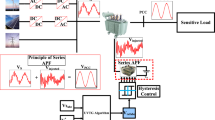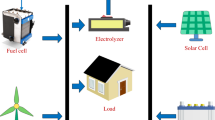Abstract
Continuous growth in size and complexity, stochastically changing power demands, system modeling errors, alterations in electric power system structures and variations in the system parameters over the time have turned automatic generation control (AGC) task into a challenging one. Hence, in this article, design of a neuro-fuzzy-based three-degree-of-freedom-PD with a low pass filter coefficient (NF-3DOF-PDN) controller for a three-area AGC system is examined in this study. Areas 1, 2, and 3 are considered hydrothermal power plants. Several secondary controllers, such as 2DOF-PDN, 3DOF-PDN, and NF-3DOF-PDN controllers, have been examined separately to maintain the frequency and tie line power. Physical restrictions, such as the generation rate constraints and the time delay, have been incorporated into the system for a more realistic approach. A skill optimization algorithm (SOA) is used to optimize the controller gains and other parameters with integral squared error as performance indices. Numerous simulations are investigated to demonstrate the superiority of the proposed NF-3DOF-PDN controller over existing secondary controllers. The impacts of combining hydrogen aqua electrolyze (HAE) and fuel cell (FC) units on dynamic systems are being studied in this system. Moreover, a unified power flow controller (UPFC) is also incorporated with the tie lines to strengthen the systems against low-frequency damping oscillations. The resilience of the SOA-optimized proposed NF-3DOF-PDN controller has also been investigated for various system loading conditions. The performance of the proposed NF-3DOF-PDN with HAE-FC and UPFC controller under nominal conditions is resilient, and it is not required for several time resets of the controller while the system loading varies.


















Similar content being viewed by others
Data availability
No, all of the material is owned by the authors, and no permissions are required.
Abbreviations
- ACEi :
-
Area controller error of ith area
- AGC:
-
Automatic generation control
- ANFIS :
-
Adaptive neuro-fuzzy inference system
- AVR:
-
Automatic voltage regulator
- FIS:
-
Fuzzy interfacing system
- FLC:
-
Fuzzy logic control
- GA:
-
Genetic algorithm
- GRC:
-
Generating rate constraint
- HAE-FC:
-
Hydrogen aqua electrolyze fuel cell units
- IAE:
-
Integral absolute error
- ID:
-
Integral derivative
- IDD:
-
Integral double derivative
- ISE:
-
Integral square error
- ITAE:
-
Integral of the time weighted absolute error
- ITSE:
-
Integral time square error
- PD:
-
Proportional-derivative
- PI:
-
Proportional–integral
- PID:
-
Proportional–integral–derivative
- PIDD:
-
Proportional–integral plus double derivative
- PIDF:
-
Proportional–integral–derivative with filter
- PIDF:
-
PID with filter
- PIDN:
-
Proportional–integral–derivative with filter coefficient
- PSO:
-
Particle swarm optimization
- TD:
-
Time delay
- 2DOF:
-
Two degree of freedom
- 3DOF:
-
Three degree of freedom
- RTP:
-
Reheated thermal power
- SLD:
-
Step load disturbance
- SOA:
-
Skill optimization algorithm
- UPFC:
-
Unified power flow controller
References
Arya Y (2019) AGC of PV-thermal and hydro-thermal power systems using CES and a new multi-stage FPIDF-(1+PI) controller. Renewab Energy 134:796–806
Balamurugan CR (2018) Three area power system load frequency control using Fuzzy Logic Controller. Int J Appl Power Eng (IJAPE) 7(1):18–26
Kothari ML, Nanda J, Kothari DP, Das D (1989) Discrete-mode automatic generation control of a two-area reheat thermal system with new area control error. IEEE Trans Power Syst 4(2):730–738
Anand B, Ebenezer Jeyakumar A (2009) Load frequency control with fuzzy logic controller considering non-linearity’s and boiler dynamics. ACSE 8(3):15–20
Patel NC, Mohanty K, Giri B, Ekka SK (2022) Load frequency control in two areas interconnected hydro-thermal power system utilizing ALO based FPI controller. In: 2022 International Conference on Intelligent.
Hannan MA, Tan SY, Al-Shetwi AQ, Jern KP, Begum RA (2020) Optimized controller for renewable energy sources integration into micro grid: Functions, constraints and suggestions. J Clean Prod 256:120419
Arya Y (2017) AGC performance enrichment of multi-source hydrothermal gas power systems using new optimized FOFPID controller and redox flow batteries. Energy 127:704–715
Chakraborty S, Singh J, Naskar AK, Ghosh S (2022) A new analytical approach for set-point weighted 2DOF-PID controller design for integrating plus time-delay processes: an experimental study. IETE J Res, pp. 1–15, 2022.
Kaya I (2003) Obtaining controller parameters for a new PI-PD Smith predictor using auto tuning. J Process Control 13(5):465–472
Vilanova R (2008) IMC based robust PID design: tuning guidelines and automatic tuning. J Process Control 18(1):61–70
Najafizadegan H, Merrikh-Bayat F, Jalilvand A (2017) IMC-PID controller design based on loop shaping via LMI approach. Chem Eng Res Des 124:170–180
Sahu RK, Panda S, ChandraSekhar GT (2015) A novel hybrid PSO-PS optimized fuzzy pi controller for AGC in multi area interconnected power systems. Int J Electr Power Energy Syst 64:880–893
Arya Y (2023) ICA assisted FTIλDN controller for AGC performance enrichment of interconnected reheat thermal power systems. J Ambient Intell Hum Comput 14:1919–1935
Prakash T, Singh VP (2018) A novel membrane computing inspired Jaya algorithm based automatic generation control of multi-area interconnected power system. In: Series in machine perception and artificial intelligence, pp 89–110
Singh O, Nasiruddin I (2016) Hybrid evolutionary algorithm based Fuzzy Logic Controller for automatic generation control of Power Systems with governor Dead Band non-linearity. Cogent Eng 3(1):1161286
Sahu RK, Gorripotu TS, Panda S (2015) A hybrid de–PS algorithm for load frequency control under deregulated power system with UPFC and RFB. Ain Shams Eng J 6(3):893–911
Shakibjoo AD, Moradzadeh M, Din SU, Mohammadzadeh A, Mosavi AH, Vandevelde L (2022) Optimized type-2 fuzzy frequency control for Multi-Area Power Systems. IEEE Access 10:6989–7002
Adetokun BB, Oghorada O, Abubakar SJ (2022) Superconducting magnetic energy storage systems: prospects and challenges for renewable energy applications. J Energy Storage 55:105663
Kottick D, Blau M, Edelstein D (1993) Battery energy storage for frequency regulation in an island power system. IEEE Trans Energy Convers 8(3):455–459
Rakhshani E, Rouzbehi K, Elsaharty MA (2017) Heuristic optimization of supplementary controller for VSC-HVDC/AC interconnected grids considering PLL. Elect Power Compon Syst 45(3):288–301
Meseret GM, Saikia LC (2023) Design of intelligent based cascaded controller for AGC in three-areas diverse sources power systems incorporated renewable energy sources with SMES and parallel AC/HVDC tie-lines. Electrical Engineering
Arya Y, Kumar N (2016) AGC of a multi-area multi-source hydrothermal power system interconnected via AC/DC parallel links under deregulated environment. Int J Elect Power Energy Syst 75:127–138
Francis R, Chidambaram IA (2015) Optimized PI+ load–frequency controller using BWNN approach for an interconnected reheat power system with RFB and hydrogen electrolyze units. Int J Electr Power Energy Syst 67:381–392
Rakhshani E, Rodriguez P (2017) Inertia emulation in AC/DC interconnected power systems using derivative technique considering frequency measurement effects. IEEE Trans Power Syst 32(5):3338–3351
Meseret GM, Saikia LC (2022) AGC in the multi-area thermal system with integration of distribution generation on the frequency of the system using the classical PID & hybrid neuro-fuzzy controllers. IETE J Res 69(12):1–10
Meseret GM, Saikia LC (2022) A comparative performance analysis evaluation of automatic generation control (AGC) of multi-area power system with the impact of HVDC links on the system frequency using the conventional PID and adaptive neuro-fuzzy controller. IFAC-Papers Online 55(1):138–143
Shankar R, Kumar A, Raj U, Chatterjee K (2018) Fruit fly algorithm-based automatic generation control of multi-area interconnected power system with facts and AC/DC links in deregulated power environment. Int Trans Electr Energy Syst, 29(1)
Arya Y, Kumar N (2017) Design and analysis of BFOA-optimized fuzzy PI/PID controller for AGC of multi-area traditional/restructured electrical power systems. Soft Comput 21(21):6435–6452. https://doi.org/10.1007/s00500-016-2202-2
Arya Y, Kumar N (2016) Fuzzy gain scheduling controllers for AGC of two-area interconnected electrical power systems. Electric Power Components Syst 44(7):737–751. https://doi.org/10.1080/15325008.2015.1131765
Meseret GM, Saikia LC (2022) AGC in the multi-area thermal system with integration of distribution generation on the frequency of the system using the classical PID & hybrid neuro-fuzzy controllers. IETE J Res
Basa Varajappa SR, Nagaraj MS (2021) Load frequency control of three area interconnected power system using conventional PID, fuzzy logic and ANFIS controllers. In: 2nd international conference for emerging technology (INCET)
Biswas S, Roy PK, Chatterjee K (2021) FACTS based 3DOF-PID controller for LFC of renewable power system under deregulation using GOA. IETE J Res
Gupta NK, Kar MK, Singh AK (2022) Design of a 2-DOF-PID controller using an improved sine–cosine algorithm for load frequency control of a three-area system with nonlinearities. Protect Control Mod Power Syst 7(1):1–18
Patel NC, Debnath MK, Sahu BK, Das P (2018) 2DOF-PID controller-based load frequency control of linear/nonlinear unified power system. Adv Intell Syst Comput, 227–236
Givi H, Hubalovska M (2023) Skill optimization algorithm: a new human-based metaheuristic technique. Comput Mater Continua 74(1):179–202
Funding
No funding was received.
Author information
Authors and Affiliations
Contributions
Getaneh Mesfin has written the whole manuscript, and Lalit Chandra Saikia has reviewed it and gives his input for modifications.
Corresponding author
Ethics declarations
Conflict of interest
The authors declare no competing interests.
Ethical approval
Not applicable.
Additional information
Publisher's Note
Springer Nature remains neutral with regard to jurisdictional claims in published maps and institutional affiliations.
Appendix
Appendix
Nominal condition system data:
Pr1 = 2000 MW, Pr2 = 6000 MW, Pr3 = 10000 MW, Initial loading = 50%, f = 60 Hz, B1 = B2 = R3 = 0.4250 p.u.MW/Hz, Ri = 2.40 Hz/per unit MW, Ptie max = 200 MW, Tg = 0.080 s, Tr = 10 s, Kr = 0.5, Hi = 5 s, Tt = 0.3 s, Di = 8.33 ∗ 10–3 p.u. MW/Hz, a12 = − 1/3, a23 = − 1/2, a13 = − 1/6, T12 = T23 = T13 = 0.0866 p.u.MW/rad, TR = 5 s, Kp1 = Kp2 = Kp3 = 120 Hz/p.u.MW, Tp1 = Tp2 = Tp3 = 20 s. KHAE = 0.02, THAE = 0.5 s, KFC = 0.01; TFC = 4 s, KUPFC = 1.0, TUPFC = 0.5 s.
Variation of parameters with varying system loading.
System loading | Kps in Hz/p.u.MW | Tps, in sec | D, in p.u. MW/Hz | B in p.u MW/Hz | Tw in sec |
|---|---|---|---|---|---|
50% | 120.0 | 20.00 | 8.33*10–3 | 0.425 | 1.00 |
65% | 93.0 | 15.0 | 0.0108 | 0.427 | 1.70 |
35% | 172.0 | 28.0 | 0.0058 | 0.4225 | 0.49” |
Rights and permissions
Springer Nature or its licensor (e.g. a society or other partner) holds exclusive rights to this article under a publishing agreement with the author(s) or other rightsholder(s); author self-archiving of the accepted manuscript version of this article is solely governed by the terms of such publishing agreement and applicable law.
About this article
Cite this article
Meseret, G.M., Saikia, L.C. Hybrid neuro-fuzzy-based 3DOF-PDN controller for AGC of multi-area interconnected power system incorporated hydrogen aqua electrolyze fuel cell units and unified power flow controller. Electr Eng (2024). https://doi.org/10.1007/s00202-024-02405-9
Received:
Accepted:
Published:
DOI: https://doi.org/10.1007/s00202-024-02405-9




